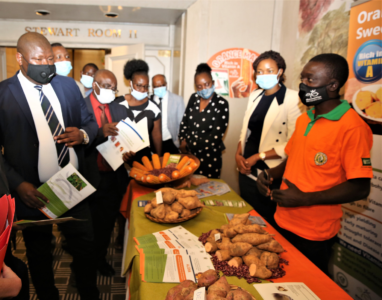
Micronutrient malnutrition is a major public health problem in Zimbabwe: One in four children between six months to five years is stunted and 19% suffer from Vitamin A deficiency (VAD) — the leading cause of preventable blindness in children. VAD can impair human growth and development and increase a child’s vulnerability to illness. VAD is also a common problem among women of childbearing age. At least one in four of these women between the ages of 15-49 is affected.
For these reasons and others, addressing malnutrition has garnered significant policy attention in Zimbabwe, where the government is working with a network of partners – including the International Potato Center (CIP) – to implement diet supplementation, industrial food fortification, diet diversification, and, more recently, crop biofortification.
Biofortification is a process of increasing the density of minerals and vitamins (specifically vitamin A, zinc, and iron) in a food crop through conventional plant breeding or agronomic practices. This approach has been proven to be quite effective at addressing malnutrition among those at most risk as it primarily targets staple crops that many resource-poor farmers grow and consume daily. Biofortified crops be used to boost iron (pearl millet, cowpea and common beans) and vitamin A (sweetpotato, cassava and maize). To date, at least 32 million people in Africa are benefitting from these biofortified crops, including many in Zimbabwe.
First things first: Performance trials and farmer preferences
In Zimbabwe, farmers have already been growing vitamin A-rich maize and zinc-fortified beans. Recently, following successful field trials and end-user research with farmers, vitamin A biofortified orange-fleshed sweetpotato (OFSP) has been added to their crop portfolios. Just one small OFSP can provide enough vitamin A for a child’s daily needs.
Using OFSP planting material from CIP, the trials were conducted under different agroecological environments in Zimbabwe and included six varieties, Alisha, Victoria, Delvia, Sumaia, Namanga and Irene. Each variety was planted during the 2019/20 agricultural season along with two non-biofortified white-fleshed local varieties (Chingova and German II) at seven research stations in 12 districts. In the end, test results showed that the OFSP variety Alisha was chosen over the white-fleshed varieties for its higher yield, taste, dry matter content and nutritional value.
“From the results, we were able to identify the most preferred varieties by farmers in the country, both in terms of their agronomic performance in the field and their taste,” said Mazvita Chiduwa, the Head of the Agronomy Research Institute in Zimbabwe’s Department of Research and Specialist Services. “OFSP turned out to be not only more nutritious but also higher yielding and much tastier, at least from the perspective of the farmers and their children. These OFSP varieties can have huge nutritional benefits while generating revenue for small-scale farmers.”
Launching OFSP in Zimbabwe

This past April, program partners, participants and representatives from the Zimbabwean government held an official launch for promoting OFSP consumption in the country.
While the program expects more than 20,000 families to add OFSP to their diets in 2021, Dr. John Basera, the Permanent Secretary for the Ministry of Lands, Agriculture, Fisheries, Water and Rural Resettlement (MLAFWRR), told those gathered that the crop promised more than improved nutrition for families. “OFSP is a hearty crop and grows well in challenging conditions. It is one of the answers to our quest for climate change adaptation.”
More than 120 farmers participated in the field trials and OFSP’s future success will continue to depend on high participation levels from farmers, said Geraldine O’Callaghan, the Deputy Director for the UK’s Foreign, Commonwealth and Development Office (FCDO).
“We know that the success achieved today… would not be possible without the commitment of communal farmers and households who are not only the end benefactors but the pioneers and trailblazers in the cultivation of biofortified crops.”
“OFSP varieties like Alisha have five important ‘highs,’” Sakile Kudita, the country manager for Zimbabwe for HarvestPlus. “ They are high in vitamin A, high yielding, have high income potential, a high level of drought tolerance, and high level of versatility because the roots and leaves are a nutrient dense, while residues can be used as livestock feed.”
The Future of OFSP in Zimbabwe
While farmer adoption of OFSP is a crucial first step, strong value chains and marketing will be needed to increase the popularity of this biofortified crop and diversify its use in Zimbabwe.
Countries such as Rwanda, Kenya, Mozambique, Malawi and South Africa are already witnessing a growing demand for OFSP due to the novel processing and commercialization opportunities it offers. Smallholder farmers are now supplying the roots to puree processing factories and earning additional incomes. Meanwhile, CIP has helped develop and promote a shelf-stable sweetpotato puree as an ingredient for buns, breads, cookies, and other baked products. As use of OFSP puree replaces about 45 percent of the wheat flour in bread, this product helps reduce overall production costs (less wheat and sugar) and offers a more nutritious product.
By Vivian Atakos (CIP) with contributions from Sakile Kudita (HarvestPlus) and Wellington Jogo (CIP).
Acknowledgements
CIP’s participation in this program is supported by FCDO through the Development and Delivery of Biofortified Foods projects (DDBIO) and includes collaboration with the Food and Agriculture Organisation of the United Nations (FAO) through the Zimbabwe Livelihoods and Food Security Programme and the Zimbabwe Ministry of Health and Child Care.
